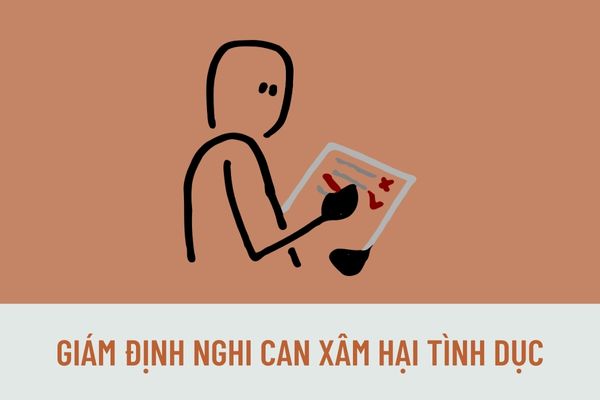What are the methods of identifying a suspect of sexual abuse in Vietnam? How to receive, assign and prepare for assessment of sexual abuse suspects?
What assessment methods are used in the process of identifying a suspect of sexual abuse?
Pursuant to subsection IV, Section 9, Appendix 1 issued together with Circular 13/2022/TT-BYT stipulating the assessment methods in the process of assessing sexual abuse suspects include:
(i) Examination
- General examination
- Genitourinary examination
- Check other parts
(ii) Indication for specialized and subclinical examination
(iii) Consultation, consult experts
(iv) Study of specimens sent for assessment or experiment

What are the methods of identifying a suspect of sexual abuse in Vietnam? How to receive, assign and prepare for assessment of sexual abuse suspects?
Vietnam: Is the assessment of a suspect of sexual abuse performed on women?
Pursuant to subsection I Section 9 Appendix 1 promulgated together with Circular 13/2022/TT-BYT, the subject of expertise is a person who has or is suspected of committing an act of sexual abuse who is solicited/requested for assessment. Accordingly, the object of assessment, regardless of male or female, can be assessed as a suspect of sexual abuse
At the same time, in subsection IV, Section 9, Appendix 1 issued together with Circular 13/2022/TT-BYT, there are regulations on methods of assessment of sexual abuse suspects, including detailed methods when performing sexual assault suspects. Currently examining the suspect is female.
Accordingly, the assessment of a suspect of sexual abuse can be carried out on women when they are solicited/requested for assessment.
What is the order to receive, assign and prepare for assessment of a sex abuse suspect in Vietnam?
Pursuant to subsection III, Section 9, Appendix 1 promulgated together with Circular 13/2022/TT-BYT stipulating the order of receiving, assigning and preparing for assessment of male sex suspects as follows:
Step 1. Receipt of solicitation/request decision, dossier and subject of expertise
- The division is assigned to receive the solicitation/request decision, dossier, object of assessment, and specimen of assessment (if any).
Dossier sent for inspection includes:
- Decide to solicit/request expertise.
- Lawful copies of dossiers and documents related to the contents to be assessed:
+ Medical records related to forensic examination (if any).
+ Decide to solicit/request expertise, conclusions of previous assessment in case of additional or re-expertise.
+ Minutes of testimonies of victims, suspects and witnesses (if any).
+ Minutes of specimen collection sealing (if any).
+ Lawful copies of other documents related to the contents to be assessed.
- Specimens (if any).
If qualified for inspection, proceed to the next steps of this process.
Refusal of assessment in case of ineligibility for assessment
Step 2. Assign professional staff
- The leader of the unit assigns forensic examiner (director) and assistant (NGV) for forensic director to conduct the assessment.
- Duties of the Director:
+ Research files and documents.
+ Direct NGV to prepare tools and equipment for inspection.
+ Work with officials of the soliciting agency/expertise requester.
+ Contact with the person being assessed.
+ Direct and guide NGV in the assessment process.
+ Examination; Take a test sample (if necessary).
+ Indication for specialized and subclinical examination.
+ Suggest and prepare to organize professional consultations, consult experts (if necessary)
+ Synthesize and evaluate the results of clinical, subclinical, specialized examination, consultation, ... make assessment conclusions.
+ Finalize the document recording the assessment process and assessment conclusions.
+ Solve problems arising in the assessment process, report results to agency leaders.
+ During the assessment process, the supervisors coordinate, discuss and agree before making the assessment conclusion.
- Tasks of the NGV:
+ Prepare tools, equipment and protective means.
+ Implement instructions for the person being assessed, measuring height, weight, pulse, temperature, blood pressure,...
+ Take photos: Portrait photos; injury photos: bruises, scars, teeth marks, deformities due to injuries, ...; Image of traces on the genitals and other places of lesions.
+ Clean tools, equipment, vehicles.
+ Gather results of subclinical, specialized examination, consultation, ...
+ Assist the supervisor in drafting a document recording the assessment process and assessment conclusions, completing the assessment photo and submitting it to the supervisor for approval.
+ Complete the inspection dossier.
+ Perform other duties as assigned by the CEO.
Step 3. Research records and documents
The assessor studies the records and documents before conducting the assessment.
Step 4. Work with the officer of the soliciting agency/examination requester
- Receive object of expertise from the soliciting agency/examination requester.
- Request officials of the soliciting agency/expertise requester:
+ Coordinate and supplement records and documents if necessary.
+ Take the assessed person to a specialist, do paraclinical tests when indicated, take the results and hand them over to the assessment agency.
+ Ensure the safety of the assessor and the person being assessed.
+ Arrange interpreters in case the assessed person is an ethnic speaker, a foreigner, or a disabled person (if necessary).
+ Arrange a guardian in case a guardian is required.
Step 5. Contact with the assessee
- Compare identity papers of the assessed person (ID card/citizen identity card, passport,...).
- Explain to the assessee about the examination procedure before conducting the assessment.
- Request the assessed person to cooperate in the assessment process.
LawNet
